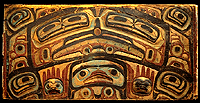
Bentwood storage boxes
 |
Boxes were used by the peoples of the Northwest Coast to store food stuffs, clothing, regalia and ritual paraphernalia. Some boxes were simply made of bent sheets of cedar bark sewn at the bottom and base to provide disposable containers for trade items, while others were more substantial and durable bentwood boxes. Food storage boxes were usually not decorated, but occasionally one such as this Haida example was painted with the image of the Chief of the Seas, the being ultimately responsible for all of the other sea creatures that the Haida used for food. Their flesh was under its guardianship while in such a box. Collected at Masset ca. 1895 by Charles F. Newcombe. CMC VII-B-324 Boxes destined to store important wealth objects were provided with a guardian spirit decoration in the form of supernatural marine beings and more familiar animals. They also had heavy plank lids. The "front" of a Haida box normally depicts Konankada (the Chief of the Undersea World), with fins as well as human hands, although the design variations are endless. |
 |
Haida burial chest with a Beaver crest, probably created by Charles Edenshaw. Collected by Harlan I. Smith in 1926 from a chief at the Gitksan village of Kitwanga on the Skeena River. Large bentwood chests, approximately the size of two storage boxes, were favoured by Haida chiefs to store and protect their regalia, particularly their costumes of Chilkat blankets or button blankets, aprons, leggings and frontlets. Important chiefs owned up to half a dozen such chests. After protecting the wealth of a chief during his lifetime, such a chest often became his burial box and the protector of his soul after death. |
 |
Burial chest; Haida; cedar; collected at Skedans in 1932 by Robert Bruce Inverarity. CMC VII-B-1881 This exquisite bentwood burial chest is one of the finest in the collection of the Canadian Museum of Civilization. On the front panel, the hands are inlaid with separately carved faces. At each corner, the salmon trout head ovoids indicate the work of an exquisite craftsman. The circles around the eyes of the human face in the lower centre of the panel are the signature feature of an unknown artist whose work was widely traded on the north coast in the mid-nineteenth century. |
